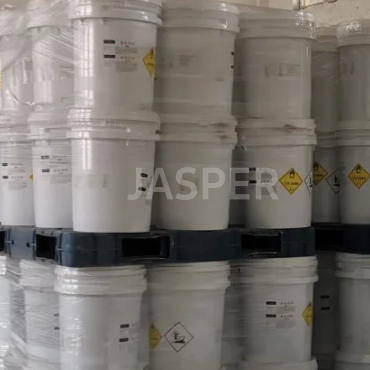Your Location:Home > Products > Solvents > Sodium Dichloroisocyanurate



CasNo: 2893-78-9
MF: C3Cl2N3NaO3
Appearance: powder
Delivery Time: 15 days
Packing: 25kg/drum
Purity: 99%
Product Details of Sodium Dichloroisocyanurate
1. Basic Information
2. Physical and Chemical Properties
3. Preparation Methods
3.1 Sodium Isocyanurate Method
Cyanuric acid and caustic soda are formulated into sodium cyanurate di - salt at a ratio of 1:2 (molar ratio). Then, chlorine gas is introduced for a chlorination reaction to generate a dichlorocyanuric acid slurry. After centrifugal separation, wet dichlorocyanuric acid is obtained. This is then put into the mother liquor of sodium dichloroisocyanurate, and caustic soda is added dropwise at a ratio of 1:1 (molar ratio) for a neutralization reaction. After the reaction is completed, the product is cooled, crystallized, and filtered to obtain wet sodium dichloroisocyanurate, which is dried to get sodium dichloroisocyanurate or its di - hydrate product.
3.2 Sodium Hypochlorite Method
Chlorine gas reacts with caustic soda to produce a sodium hypochlorite solution with a concentration of 10% - 11%. Then, sodium hypochlorite and isocyanuric acid undergo a chlorination reaction to generate sodium dichloroisocyanurate and sodium chloride products. During the reaction, the pH value can be controlled by supplementing chlorine gas. In this way, the sodium hydroxide generated by the reaction can react with chlorine gas to form sodium hypochlorite, which continues to participate in the reaction, making full use of the reaction raw materials. However, since chlorine gas is involved in the chlorination reaction, strict control of the raw material cyanuric acid and reaction conditions is required; otherwise, an explosion accident of nitrogen trichloride is likely to occur. Another way is to use inorganic acids (such as hydrochloric acid) for neutralization. This method does not involve direct participation of chlorine gas in the reaction, so the operation is easier to control, but the utilization of the raw material sodium hypochlorite is not complete.
3.3 Isocyanuric Acid Metathesis Method
Sodium salt reacts with chlorine gas at a certain temperature for a chlorination reaction to generate trichloroisocyanuric acid, which is then centrifugally filtered to obtain wet trichloroisocyanuric acid. Trichloroisocyanuric acid, cyanuric acid, and sodium hydroxide solution are subjected to a metathesis reaction at a ratio of 2:1:3 (molar ratio) at 30 - 40℃. After cooling, crystallization, filtration, and drying, powdery sodium dichloroisocyanurate product is obtained.
4. Product Uses
4.1 Disinfection and Sterilization
4.2 Wool Anti - shrink Treatment
The aqueous solution of sodium dichloroisocyanurate can evenly release hypochlorous acid, which reacts with the protein molecules in the wool scale layer, breaking some of the bonds in the wool protein molecules, thereby achieving the effect of preventing wool shrinkage. In addition, when used to treat wool products, it can also prevent the "pilling" phenomenon during wool washing. Wool fabrics treated with sodium dichloroisocyanurate have bright colors and good hand feel, and basically do not shrink. Adding a 2% - 3% sodium dichloroisocyanurate solution and other auxiliaries to impregnate wool or wool - blended fibers and fabrics can effectively prevent pilling and felting of wool and its products.
4.3 Textile Industry Bleaching
In the textile industry, it is mainly used as a bleaching agent for natural fibers and synthetic fibers. In water, sodium dichloroisocyanurate can produce hypochlorous acid. Hypochlorous acid can react with the conjugated bonds of chromophores in fibers through an addition reaction, changing the wavelength of light absorption by the fibers and destroying the pigments in the fibers, thus achieving the purpose of bleaching. Compared with traditional bleaching agents, it has many advantages. Traditional bleaching agents can only be used at low temperatures because high temperatures will accelerate the destruction of the fiber molecular structure, resulting in a rapid decrease in fiber strength. However, sodium dichloroisocyanurate can achieve good bleaching effects even at low temperatures. Moreover, it has a slow destruction rate of the molecular structure of natural and synthetic fibers, good bleaching results, and little impact on fiber strength. In addition, adding sodium dichloroisocyanurate to bleaching agents can also improve the hydrophilicity of clothing, remove cotton pulp from clothing, reduce the degradation rate of cellulose, and improve the flexibility and extensibility of clothing.
4.4 Other Uses
5. Packaging and Storage
5.1 Packaging
Common packaging includes 25 - kg plastic - woven bags, 25 - kg or 50 - kg plastic drums, 50 - kg cardboard drums, etc. Customized packaging can also be provided according to user requirements.
5.2 Storage
It should be stored in a cool, dry, and well - ventilated warehouse, away from fire sources and heat sources. Avoid storing it together with easily oxidizable substances, ammonia, ammonium salts, etc.
6. Safety Precautions
The aqueous solution of sodium dichloroisocyanurate has certain irritating effects on the skin and mucous membranes, and the irritating odor it emits may also cause damage to the respiratory tract. Appropriate protective measures should be taken when using it, such as wearing protective gloves, masks, and goggles to avoid direct contact with the skin, eyes, and respiratory tract.